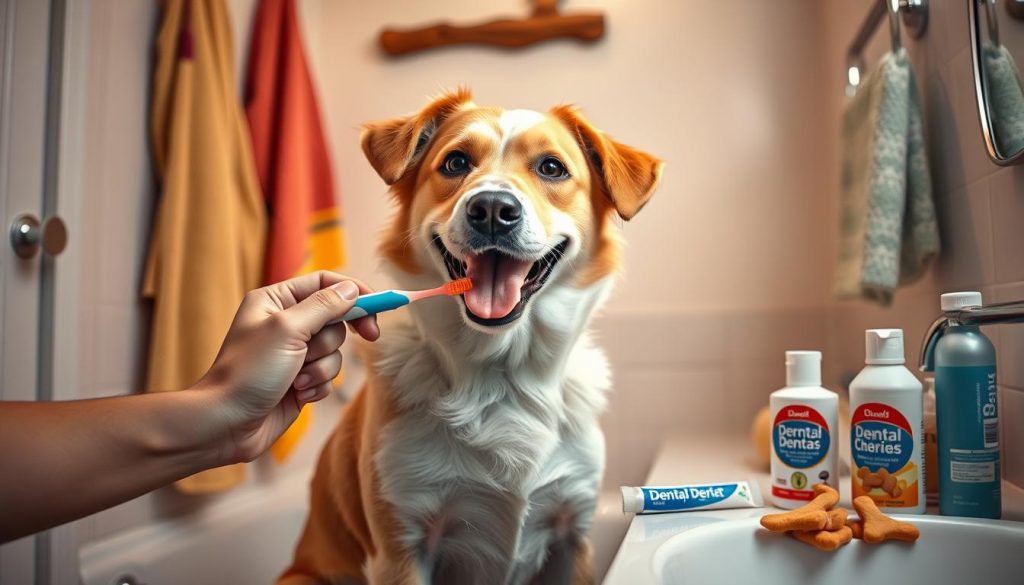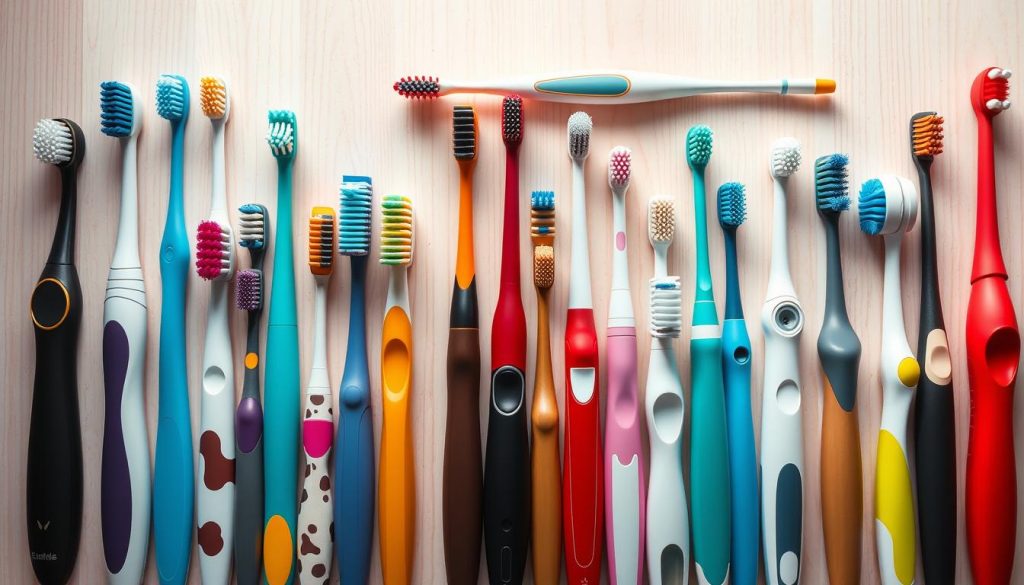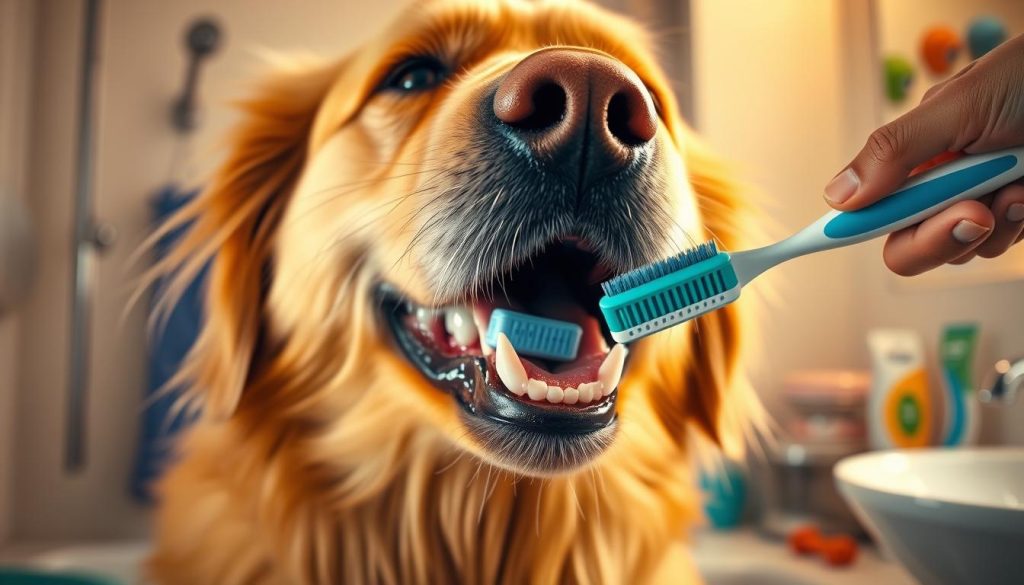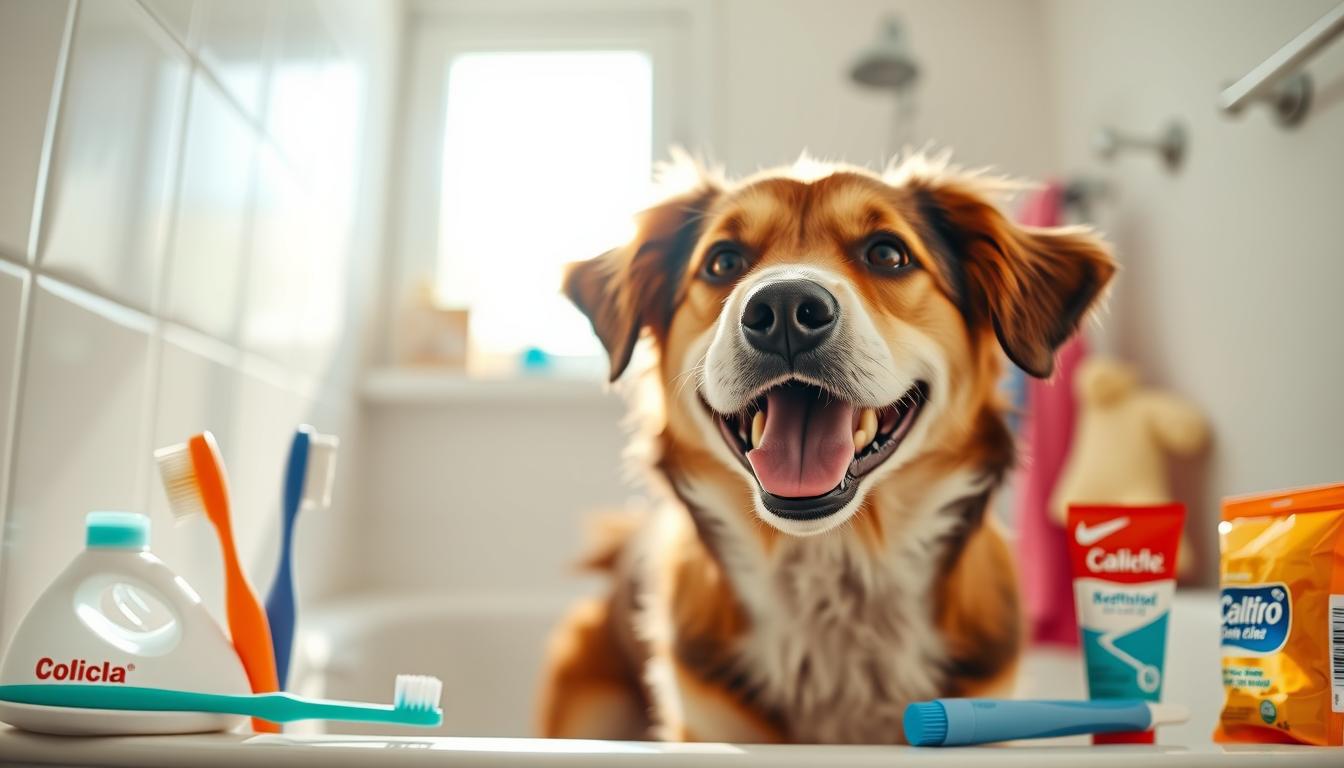As a devoted dog owner, I know how vital dog dental care is. It’s key to their overall health. By following the right tips, I can keep my pup’s smile bright for years.
In this guide, I’ll cover why canine oral hygiene is important. I’ll also share steps for effective dog teeth brushing. Plus, I’ll talk about dental care products that keep teeth and gums healthy.
Caring for my dog’s teeth is more than just fresh breath. It helps prevent serious issues like periodontal disease. Learning to clean their teeth and spotting problems early is crucial.
By doing this, I can keep their dental health in check. This avoids expensive vet visits later. Let’s explore the essential dog dental care tips together.
Importance of Canine Oral Hygiene
Keeping your dog’s mouth clean is key to their health. If you ignore their dental care, they might get periodontal disease. This can cause tooth loss, gum problems, and even be life-threatening. Also, fresh breath is important for your dog’s comfort and your home’s cleanliness.
Preventing Periodontal Disease
Periodontal disease is common in dogs and can get worse fast if not treated. It happens when plaque and tartar build up, causing gum inflammation and infection. If not treated, it can damage the bone and lead to tooth loss. Regular brushing and dental cleanings can prevent this and keep your dog’s mouth healthy.
Maintaining Fresh Breath
Dog bad breath often means there’s a dental problem, like bacteria buildup or rotting food. Brushing your dog’s teeth regularly and using dental chews can fight this. It keeps their breath smelling good and fresh.
By focusing on your dog’s dental care, you keep their mouth healthy. This prevents painful and expensive dental issues. It also ensures their overall health. Taking care of your dog’s teeth now will make them happy, healthy, and comfortable for years.
Dog Dental Care: A Step-by-Step Guide

Keeping your dog’s teeth clean is vital for their health. Here’s a simple guide on how to brush your dog’s teeth and keep their dog dental care routine on track.
- First, get the right tools: a soft-bristled toothbrush, toothpaste safe for dogs, and treats for a reward.
- Let your dog get used to the toothbrush and toothpaste slowly. Let them sniff and explore before brushing.
- Begin by gently lifting your dog’s lip and brushing the outer teeth in circles. Pay extra attention to the back teeth, where plaque and tartar often accumulate.
- Move around your dog’s mouth, brushing all the teeth you can see.
- If your dog lets you, brush the inside of their teeth too.
- End with a treat or praise to make the experience positive.
Consistency is crucial in how to brush dog’s teeth and keeping up with their dental care routine. Brush your dog’s teeth a few times a week. Be patient as they adjust to it. With time and rewards, they’ll come to enjoy dental care.
Choosing the Right Toothbrush and Toothpaste

Choosing the right dental care products for your dog is key to keeping their mouth clean. When looking for the best dog toothbrushes and toothpaste, there are important factors to consider.
Selecting Dog-Friendly Products
First, make sure the products are made for dogs. Human toothbrushes and toothpaste can harm your pet. They may have ingredients that are toxic to dogs.
Look for toothbrushes with soft bristles that won’t hurt your dog’s gums. Also, choose toothpaste that is safe for dogs. It should not have fluoride, xylitol, or other harmful additives.
When picking a toothbrush, think about your dog’s size and breed. Smaller dogs need smaller brushes, while bigger dogs need wider ones. Some brushes have special features like angled heads or finger mounts to make brushing easier.
For toothpaste, find formulas that dogs like. Many brands offer flavors like chicken, beef, or peanut butter. This makes brushing more fun for your dog.
The goal of dog dental care is to find products your dog will like. With the right toothbrush and toothpaste, you can keep your dog’s mouth healthy. Plus, it makes brushing a positive experience for both of you.
Dog Dental Care: Brushing Techniques

Keeping your dog’s teeth clean is vital for their health. Learning how to brush dog’s teeth correctly is essential. Here are some tips to help you brush your dog’s teeth effectively:
- Start early: Begin brushing your dog’s teeth as early as possible, even as a puppy. This will help them get used to the process and make it a positive experience.
- Choose the right tools: Select a soft-bristled toothbrush designed specifically for dogs, and use a pet-safe toothpaste. Avoid using human toothpaste, as it can be harmful if swallowed.
- Go slow and be patient: Introduce the toothbrush gradually, and let your dog get comfortable with the sensation. Praise and reward them throughout the process to make it a positive experience.
- Focus on the gum line: When brushing, concentrate on the gum line, as this is where plaque and tartar tend to build up the most.
- Brush in a circular motion: Gently brush your dog’s teeth in a circular motion, ensuring you cover all surfaces.
- Make it a routine: Aim to brush your dog’s teeth regularly, ideally every day or every other day, to maintain optimal oral health.
By following these how to brush dog’s teeth correctly and dog teeth brushing tips, you can help keep your canine companion’s smile healthy and bright. Remember, consistency and positive reinforcement are key to making teeth brushing a stress-free experience for both you and your furry friend.
Signs of Dental Problems in Dogs
As pet owners, we must watch our dogs’ dental health closely. Spotting dental issues early can prevent bigger problems later. Here are key signs to look for in your dog’s dental health.
Red Flags to Watch Out For
- Persistent bad breath: If your dog’s breath smells bad all the time, it might mean dental problems.
- Discolored or tartar-covered teeth: Yellow or brown teeth could show plaque and tartar buildup.
- Swollen or inflamed gums: Healthy gums are pale pink. Red and swollen gums suggest gum disease.
- Difficulty chewing or loss of appetite: Pain while eating could be due to dental issues.
- Excessive drooling: Too much drooling might mean dental pain or infection.
- Bleeding gums: Bleeding gums are a clear sign of gum disease and need quick attention.
If you see any of these signs in your dog, get a vet appointment fast. Early treatment can stop serious and expensive dental problems.
Professional Dental Cleanings for Dogs
As a responsible dog owner, it’s key to get your furry friend regular dental cleanings. These cleanings help prevent gum disease, keep breath fresh, and keep teeth and gums healthy.
During a dental cleaning, a vet or certified tech will check your dog’s mouth. They remove tartar, polish teeth, and look for dental problems. This deep clean is vital for removing plaque and bacteria that brushing can’t catch.
It’s best to get your dog’s dental cleanings done yearly, or more often if your vet says so. To make the visit easy for your dog, get them used to the vet and provide a calm space. Also, follow any pre-visit advice from your vet.
- Familiarize your dog with the veterinary clinic and staff beforehand
- Provide a calming environment during the procedure
- Follow any pre-appointment instructions from your vet
By focusing on dog dental cleanings and listening to your vet, you can keep your dog’s smile healthy and happy for many years.
| Procedure | Benefits | Frequency |
|---|---|---|
| Professional Dog Dental Cleanings |
|
At least once a year, or as recommended by your veterinarian |
Dental Chews and Treats for Canine Oral Health
Adding dental chews and treats to your dog’s diet is a great way to help their teeth. These snacks are made to remove plaque and tartar. They keep your dog’s teeth and gums healthy.
For the best dental chews, choose ones with natural ingredients and the VOHC seal. Brands like Greenies and Dentastix are good choices. They clean your dog’s teeth as they chew, improving their gums and breath.
You can also find dog dental treats that support oral health. These treats, often made with chicken or sweet potato, are tasty rewards. Make sure to pick VOHC-approved treats for the best results.

